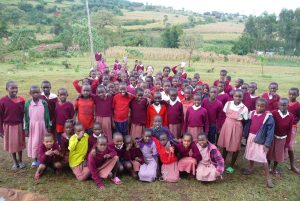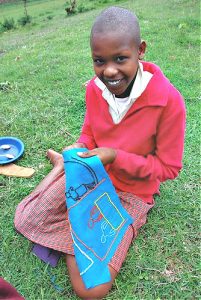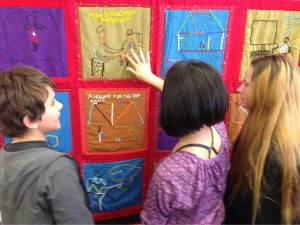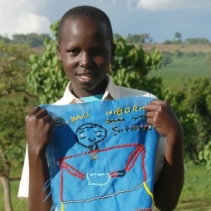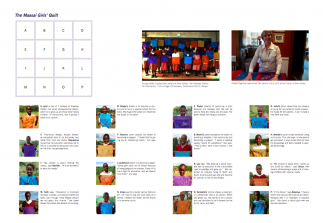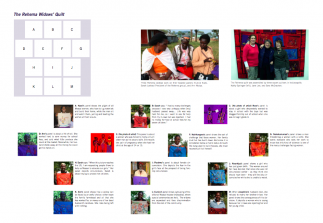The Maasai Girls Quilt
Background
|
In 2009 AP developed a partnership with Kakenya Ntaiya, the pioneering Kenyan advocate for girl’s education. Kakenya had started a boarding school for girls from underprivileged families in her home village Enoosayen, Trans Mara county. As well as offering an excellent education, the Kakenya’s Center of Excellence (KCE) also made a strong statement against the practice of genital cutting. The school would only admit a girl if her parents agreed not to have her cut. Kakenya herself had gone through the ordeal when young but struck a bargain with her father at the time: she would submit if he sent her to school. Kakenya went on to earn a PHD in the US and be named a top CNN hero in 2013. In 2010. we deployed Charlotte Bourdillon, a recent graduate from Tufts University, to work as a Peace fellow at KCE. During her stay, Charlotte worked on two advocacy quilts with the Rehema Widows and with girls from the KCE school. These spectacular two quilts are made with beads and a scarlet backing, in the Maasai tradition. The original idea had been to work only with girls. But Kakenya’s mother (“Mama Kakenya”) suggested that working with widows as well would give a more rounded picture of the life of women and girls. In the summer of 2011 Charlotte was joined by a second Fellow, Clea Noia, also from Tufts. The two Fellows used their computers to bring up photos of other advocacy quilts from Bosnia and the DRC, and explain the concept of advocacy quilting to the girls and the Rehema group. Cleia described the process in a blog, Stories Worth Telling. The young artists were in Grade 6 and they decided to make blocks about the importance of education. Unlike the Rehema widows, who had all been cut, the girls had escaped genital cutting when they enrolled in the school and their quilt was optimistic. They used their panels to express their dreams for the future. Charlotte and Cleia reserved some time after school, and invited a local beading expert, Parako, to gove some basic training. As Charlotte wrote in a blog, this helped to instill a respect for Maasai traditions in the girls: “Only around 20% of the girls had been taught how to create traditional beadwork by their mothers or grandmothers. Again, Kakenya works to emphasize positive aspects of Maasai culture while also educating about the harmful aspects.” The girls needed no incentive to produce their beaded panels and relished the opportunity to tell their stories through art. As Charlotte wrote: “ They) love having a craft to work on during their free time. I keep finding them in the classroom working on their projects during lunch!” 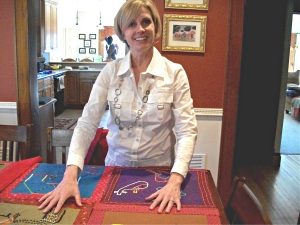 Before assembling the Maasai Girls Quilt at her home in New Jersey, Onalie Gagliano visited KCE in Kenya with her daughter. The process produced some delightful vignettes. Peyiai was one of two girls who wanted to be a helicopter pilot. Gladys said that she wanted to build a school for handicapped children when she grew up. Brenda depicted herself at the computer, learning new things from the Internet. Charlotte returned to the United States with both sets of blocks to begin the process of assembling the two quilts. Her mother’s quilting guild in Indianapolis took on the Rehema quilt while Onalie Gagliano an expert quilter in New Jersey agreed to take on the Maasai Girls Quilt. Onalie has a deep affection for Kakenya, and has twice visited the school with her own daughters. She was particularly taken by the humorous images. The Maasai Girls Quilt has featured in exhibitions around the world and never fails to entrance visitors. It was first show at the United Nations in 2012. One of those present was Megan Orr, who worked as a Peace Fellow at KCE later in the year. Megan herself loved the quilts, and one of the first things she did on arriving in Enoosaen was bring up the photos on her laptop. As she later wrote in a blog, the girls were wide-eyed with fascination when Megan brought up the photos of their own panels and showed them the finished quilt, so beautifully arranged by Onalie. It also helped Megan to understand the empowering impact of technology: “These girls were fascinated and completely plugged into the reality that they were on the Internet.” This was one of the few times that AP has been able to return and reconnect artists with the quilts they had helped to make. The quilt also made a memorable appearance at the Thompson Middle School in Newport Rhode Island, in 2015, when Iain from AP used it describe some of the challenges facing girl students in Africa. The quilt then returned to Kenya in November 2019, to be exhibited at the ICPD25 UN summit on women and girls. In the years since, Kakenya’s work has gone from strength to strength and the young artists have gone on to High School and college. We urge you to visit the KCE website and learn more about their remarkable journey. (September 2020) |
Artists and blocks
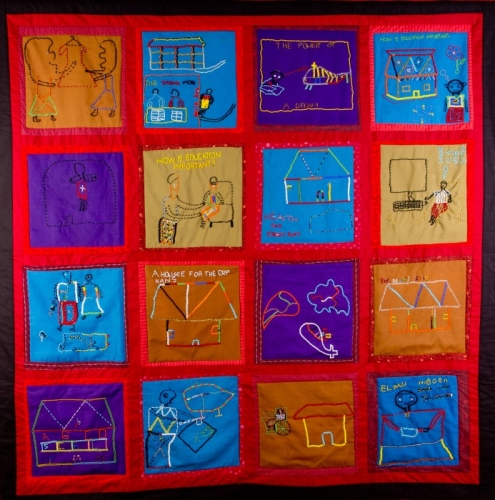 |
|
Lynn Lynn is one of 7 orphans at Kakenya Center. Her panel represents her dream to grow up and be able to help other needy children. In the picture, she is giving a dress to an orphan. |
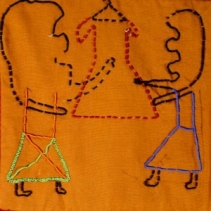 |
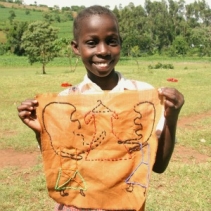 |
|
Napukenya While Maasai have traditionally lived in manyatta homes, education will free Napukenya to live in a concrete house and build a better life for herself than her grandparents could. |
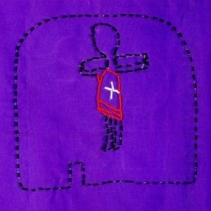 |
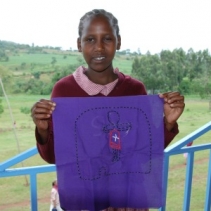 |
|
Nasieku “My picture is about helping the needy,” says Nasieku. “It is so wonderful to help the needy.” |
 |
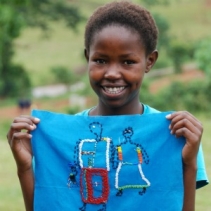 |
|
Faith Faith says, “Education is important because it allows us to read and write and spell, even though many Maasai people are not given this chance.” Her panel shows the school she dreams of building. |
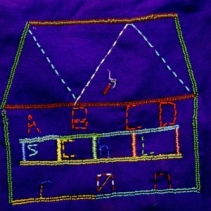 |
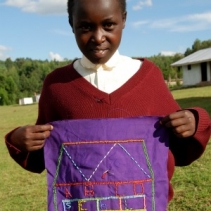 |
|
Gladys Gladys’ dream is to become a doctor and to build a special school for the blind. The house in her panel is what she hopes this school will look like. |
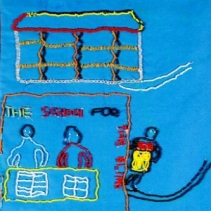 |
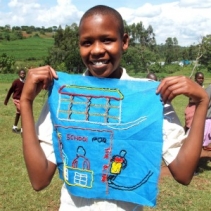 |
|
Sharon Sharon’s panel depicts her dream of becoming a surgeon. “I thank God for giving me an interesting dream,”she says. |
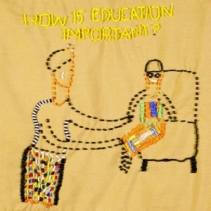 |
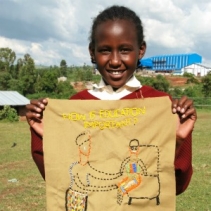 |
|
Jackeline Jackeline’s dream is to become a lawyer. “Some girls drop out of school because of being pregnant or orphans. Every child has a right to education, and we should help them,” she says. |
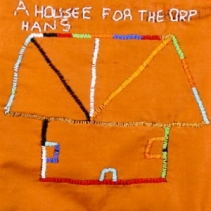 |
|
|
Vivian Vivian wants to study hard so that she will not have to dig and work hard as a farmer. Instead, her dream for the future is to become a pilot. |
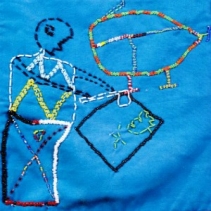 |
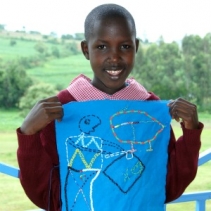 |
|
Peyiai Peyiai dreams of becoming a pilot because she believes that she will be able to help the needy and the poor. Her panel shows her flying an airplane. |
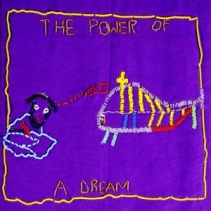 |
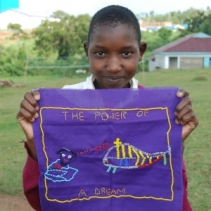 |
|
Naomi Naomi’s panel represents her dream of building a hospital in her community and becoming a surgeon. “I wrote a heading saying ‘health for everybody,’” she says.“That is why I want to be a doctor in the future.” |
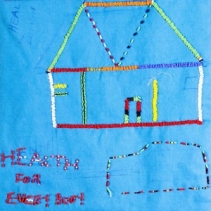 |
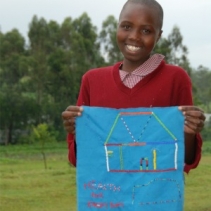 |
|
Lyn Lyn says, “I drew about how I will use my education in the future when I get knowledge and grow up.” She depicted an airplane flying to North and South America and says she will become an optician in the United States. |
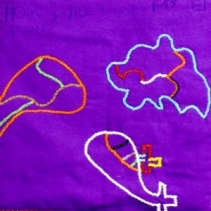 |
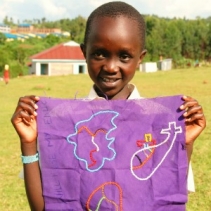 |
|
Nenkoitoi Nenkoitoi’s picture shows a small girl in a wheelchair who is an orphan. When she grows up, she wants to be a doctor and use her salary to build houses for the blind, disabled, and deaf. |
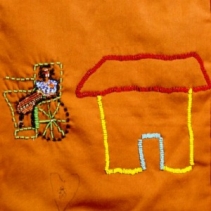 |
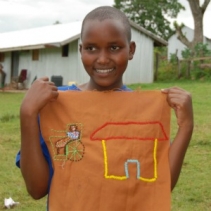 |
|
Juliet Juliet’s panel shows her dream of using her education to build a beautiful house for her parents, including a new farm and cows. |
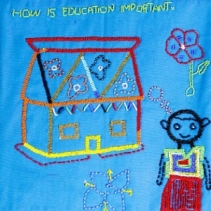 |
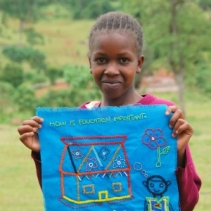 |
|
Brenda Brenda’s panel shows someone using a computer. She says that it represents how a person can acquire education and how this allows them to have knowledge and skills needed to operate technology. |
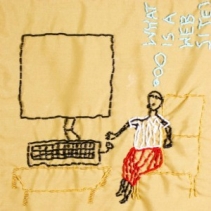 |
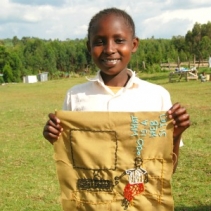 |
|
Shura “My picture is about when I grow up and build our nation,” says Shura. She dreams of becoming a nurse and of helping children with special needs. |
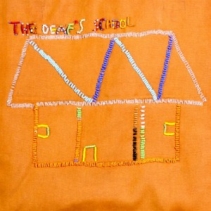 |
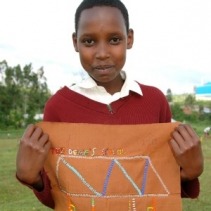 |
|
Kakenya “In the future,” says Kakenya, “I have a dream that I would like to advise and teach Kenyans why it is important to educate girls.” Her panel is about girls who are denied education. |
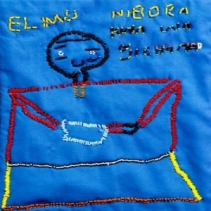 |
|

